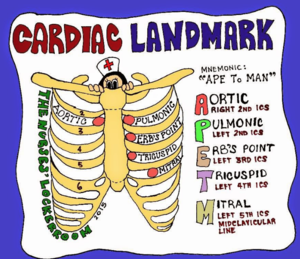14073951
post-op quiz
Resource summary
Question 1
Question
Nursing diagnosis statements
Made up of
1) [blank_start]Diagnosis[blank_end]
2 ) [blank_start]What the diagnosis is related to[blank_end]
3) [blank_start]Evidence[blank_end] for this
Answer
-
What the diagnosis is related to
-
Diagnosis
-
Evidence
Question 2
Question
Post op obs
Generally (if a patient is stable these are):
Every [blank_start]15[blank_end] minutes for the first [blank_start]hour[blank_end]
Every [blank_start]30[blank_end] minutes for the next [blank_start]two[blank_end] hours
and then [blank_start]once[blank_end] an hour for the subsequent [blank_start]four[blank_end] hours
Answer
-
15
-
30
-
hour
-
two
-
once
-
four
Question 3
Question
Post-op orders
These guide the nurse in the post-operative care of the patient
activity [blank_start]level[blank_end]
diet
[blank_start]medications[blank_end] including antibiotics
[blank_start]frequency[blank_end] of obs
any IVFs that need administering
[blank_start]laboratory[blank_end] tests to be conducted
Answer
-
level
-
medications
-
frequency
-
laboratory
Question 4
Question
Post-op Haemorrhage
An excessive loss of [blank_start]blood[blank_end].
Nursing care:
Applying one or more gauze pads and a firm pressure dressing to the area
Applying [blank_start]pressure[blank_end] with gloved hands
Preparing person and their family for [blank_start]emergency surgery[blank_end]
Answer
-
blood
-
pressure
-
emergency surgery
Question 5
Question
DVT
Formation of a [blank_start]thrombus[blank_end] in association with [blank_start]inflammation[blank_end] in deep veins
Most common in [blank_start]lower[blank_end] extremities of post-op patient
Common assessment findings in those with DVT:
[blank_start]Pain[blank_end]/cramping in the involved calf or thigh
Redness, tenderness, [blank_start]warmth[blank_end], discolouration of the skin and [blank_start]oedema[blank_end] of the entire extremity may occur with a slightly elevated temp
May have positive Homan's sign
Pain in the [blank_start]calf[blank_end] on dorsiflexion of the foot
Suspected DVT can be confirmed by duplex doppler scans however some can be [blank_start]asymptomatic[blank_end]
Nursing care:
Administer [blank_start]anticoagulants[blank_end] as charted
Monitor path results for [blank_start]clotting[blank_end] times
Compression stockings or devices to stimulate [blank_start]venous[blank_end] returns
Educate the patient to not massage or rub affected area
Record bilateral calf/thigh [blank_start]circumference[blank_end] every shift
Neurovasc obs for affected limb each shift
Answer
-
thrombus
-
inflammation
-
lower
-
Pain
-
warmth
-
oedema
-
calf
-
asymptomatic
-
anticoagulants
-
clotting
-
venous
-
circumference
Question 6
Question
Pneumonia
[blank_start]inflammation[blank_end] of the [blank_start]lung[blank_end] tissue
Caused by microbial [blank_start]infection[blank_end] or foreign substance that leads to an infection.
Nursing care:
[blank_start]Sputum[blank_end] culture collection
[blank_start]Elevate[blank_end] head of the bed
Encourage turning, coughing and deep breathing every [blank_start]two hours[blank_end]
Assist with incentive spirometry & neb treatments as ordered
[blank_start]Ambulate[blank_end] the person as is permitted and prescribed
Administer oxygen as ordered
Maintain [blank_start]hydration[blank_end] to help with expectoration
Administer medication as ordered
Answer
-
inflammation
-
lung
-
infection
-
Sputum
-
Elevate
-
two hours
-
Ambulate
-
hydration
Question 7
Question
Wound healing intention
1) [blank_start]Primary[blank_end] intention
[blank_start]uncomplicated[blank_end] wounds that sustain little [blank_start]tissue[blank_end] loss. The edges are well-[blank_start]approximated[blank_end] with stitches or staples. Heals [blank_start]quickly[blank_end] with little scarring
2) [blank_start]Secondary[blank_end] intention
Large, gaping and irregular.
Tissue loss stops wound [blank_start]edges[blank_end] from approximating
Takes longer to heal, more [blank_start]infection[blank_end] prone and larger scarring.
3) [blank_start]Tertiary[blank_end] intention
If lots of time passes before a wound is sutured, tertiary intention will take place. The wound edges will not have taken place and the scar will be [blank_start]large[blank_end]. This can also occur if stitches are not well [blank_start]approximated[blank_end] or burst/ wound becomes dehisced.
Answer
-
Primary
-
tissue
-
quickly
-
approximated
-
uncomplicated
-
Secondary
-
edges
-
infection
-
Tertiary
-
large
-
approximated
Question 8
Question
Stages of wound healing
Stage 1
From surgery to day [blank_start]2[blank_end]
[blank_start]Inflammatory[blank_end] process prepares tissue for healing.
Blood vessels constrict - [blank_start]clotting[blank_end] occurs
Plasma, WBCs and [blank_start]fibroplastin[blank_end] arrive at the wound site.
Mild temp ^ is [blank_start]normal[blank_end]
Stage 2
Day 3 - day [blank_start]14[blank_end]
Fewer WBCs
[blank_start]Collagen[blank_end] tissue forms in the wound
[blank_start]Granulation[blank_end] tissues are established - red with a rich blood supply.
Answer
-
2
-
Inflammatory
-
clotting
-
fibroplastin
-
normal
-
14
-
Collagen
-
Granulation
Question 9
Question
Wounds healing though TIME
T - [blank_start]Tissue[blank_end]
I - [blank_start]Infection[blank_end]
M - [blank_start]Moisture[blank_end] (heavy exudate)
E - [blank_start]Edge[blank_end] of wound not closing
Answer
-
Tissue
-
Infection
-
Moisture
-
Edge
Question 10
Question
Serous drainage
Contains mostly the clear [blank_start]serous[blank_end] portion of the blood. Appears clear or slightly [blank_start]yellow[blank_end] and thin in consistency.
Sanguineous drainage
[blank_start]combination[blank_end] of serum and RBCs and has a thick, reddish appearance. Most common drainage from non-complicated wound.
Purulent drainage
composed of WBCs, tissue [blank_start]debris[blank_end] and [blank_start]bacteria[blank_end].
Result of [blank_start]infection[blank_end]
Thicker constency
Various colours -> specific to [blank_start]organism[blank_end]
Unpleasant odour
Answer
-
yellow
-
serous
-
combination
-
debris
-
bacteria
-
infection
-
organism
Question 11
Question
[blank_start]Dehiscence[blank_end] is the separation of the layers in the incisional wound.
May require resuturing if deemed necessary.
[blank_start]Evisceration[blank_end]
Protusion of bodily [blank_start]organs[blank_end] from the wound dehiscence.
Answer
-
Dehiscence
-
Evisceration
-
organs
Want to create your own Quizzes for free with GoConqr? Learn more.
Similar
1. Craniul – particularități structurale și compartimente. Oasele occipital, frontal, parietal şi sfenoidul.
Hard Well

